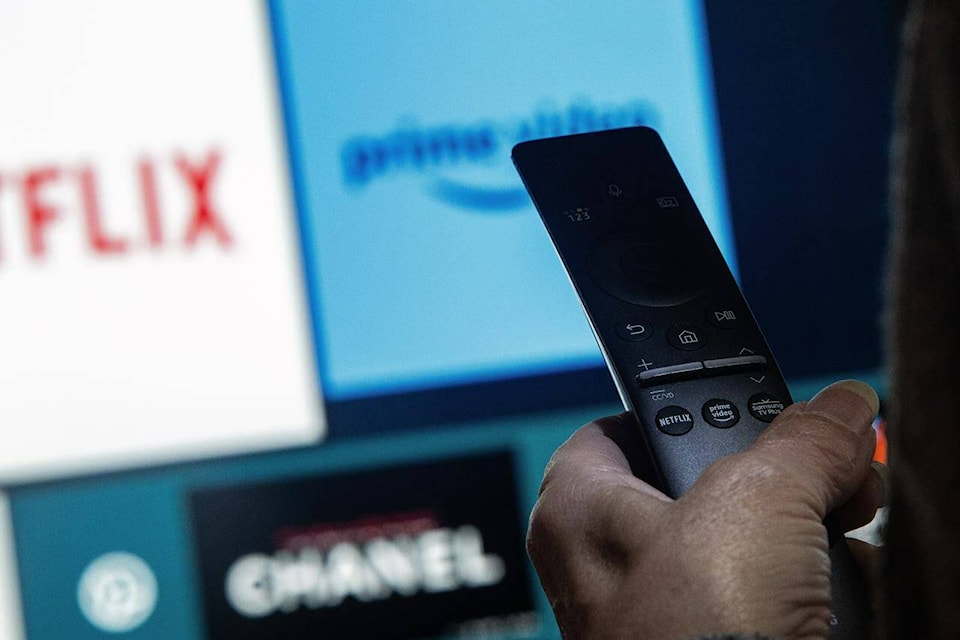A new report suggests Canadians���߲��о��� television viewing habits continue to shift toward streaming platforms at the expense of traditional cable and satellite subscriptions, at a time when the federal regulator is considering new rules to help level the playing field across the sector.
The annual Couch Potato Report released Monday by Convergence Research says 42 per cent of Canadian households did not have a TV subscription with a traditional provider by the end of last year. It forecasts that by the end of 2026, half of all households won���߲��о���t be traditional TV watchers.
Meanwhile, the report says more than 80 per cent of Canadian households subscribe to a streaming service, while 70 per cent subscribe to both TV and one or more streaming services.
Last year saw 2.6 per cent of Canadian TV subscribers cut the cord, as the revenue brought in by traditional TV providers declined three per cent to $7.2 billion ���߲��о��� a pace the report predicts will continue through 2026.
Meanwhile, streamers���߲��о��� Canadian subscription revenue rose 14 per cent in 2023 to $3.73 billion and is forecast to reach $4.24 billion this year.
���߲��о���It���߲��о���s kind of a no-brainer that the alternative is going to be, and continues to be, the Netflixes and the Amazons and the Apples of the world. This is where your content lives,���߲��о��� said Convergence Research president Brahm Eiley.
���߲��о���This is where the big spending is happening for programming. These guys are obviously kind of winning the battle at the end of the day.���߲��о���
The continued growth of streaming in Canada came despite the average price of those services rising 12 per cent last year across the 10 largest providers.
The report noted Canadians found ���߲��о���significant���߲��о��� savings associated with streaming packages that require the viewer to watch advertisements. Customers with these packages paid an average of 42 per cent less than those subscribed to ad-free alternatives.
Streaming customers pay for an average of 2.5 platforms per household.
The report estimates just four in ten U.S. households had a subscription to a traditional provider at the end of 2023 ���߲��о��� a figure it forecasts will decline to one-quarter by 2026.
Eiley said the shift from TV to streaming platforms is happening less rapidly in Canada than in the U.S.
He added one of the reasons that decline has been less severe in Canada is due to the high number of new people moving to the country each year, which is fuelling Canada���߲��о���s population growth.
���߲��о���On the TV side, it���߲��о���s kept things from really falling off the cliff,���߲��о��� he said.
But the struggles felt by Canada���߲��о���s broadcasting sector have been significant enough to prompt calls for reform ���߲��о��� and help ���߲��о��� from the CRTC.
The federal regulator held a 15-day hearing late last year that focused on modernizing the regulatory framework for broadcasters.
It was part of a public consultation in response to the Online Streaming Act, which received royal assent last April and is meant to update federal legislation to require digital platforms to contribute to and promote Canadian content.
The commission is exploring whether foreign streamers should be asked to make an initial contribution to the Canadian content system. It has said that could help balance the scales for local television and radio companies that are already required to support Canadian content.
Major Canadian broadcasters and telecom giants, such as Rogers Communications Inc., BCE Inc., Telus Corp. and Quebecor Inc., had urged the CRTC to amend the regulatory framework to account for subscribers and revenues shifting from the traditional system to foreign streaming services.
Meanwhile, streamers largely encouraged the regulator to hold off on imposing such contributions. Netflix argued the CRTC should recognize the role it already plays in helping fund Canada���߲��о���s broadcasting industry and reject calls to mandate an additional payment from the company.
The CRTC is aiming to develop and implement its new regulatory framework by the end of this year.
Eiley said it���߲��о���s unsurprising that the popularity of streaming continues to grow, noting there are dozens of options available to Canadians, when accounting for the many smaller services that offer niche programming.
���߲��о���It���߲��о���s not just the big players, Eiley said. ���߲��о���There���߲��о���s specific movie offerings, there���߲��о���s sports offerings, there���߲��о���s horror offerings, there���߲��о���s everything. There���߲��о���s quite a diversity on the streaming side.���߲��о���
READ ALSO:
READ ALSO:



